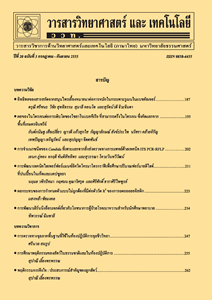อิทธิพลของโอไรซาลินต่อการเปลี่ยนแปลงสัณฐานวิทยาของหงส์เหินดอกสีชมพู
Main Article Content
Abstract
บทคัดย่อ
หงส์เหินจัดเป็นไม้ดอกที่ต่างประเทศเริ่มให้ความสนใจและมีความต้องการเป็นจำนวนมาก เนื่องจากมีรูปทรงดอกที่แปลกตา ประเทศผู้นำเข้าหัวพันธุ์หงส์เหิน ได้แก่ ญี่ปุ่น และเนเธอร์แลนด์ สำหรับประเทศไทยการใช้หงส์เหินในการปักแจกันและไม้กระถางประเภทนี้ยังไม่แพร่หลายมากนัก เนื่องจากมีความหลากหลายน้อย และสีสันยังไม่เป็นที่สะดุดตา นอกจากนี้ข้อมูลเกี่ยวกับการผลิตและการปรับปรุงพันธุ์ยังมีไม่เพียงพอ ในการ ศึกษานี้เพื่อชักนำให้เกิดการเปลี่ยนแปลงสัณฐานวิทยา โดยศึกษาผลของโอไรซาลินที่ระดับต่าง ๆ ต่อการเปลี่ยนแปลงสัณฐานวิทยาของต้นหงส์เหินในสภาพปลอดเชื้อ โดยวางแผนการทดลองแบบสุ่มสมบูรณ์ พบว่าการได้รับโอไรซาลินที่ระดับความเข้มข้นต่ำเป็นระยะเวลานาน สามารถชักนำให้เกิดการเปลี่ยนแปลงสัณฐานวิทยาได้ และที่ระดับความเข้มข้น 0.1 มิลลิกรัมต่อลิตร นาน 5 วัน ทำให้ใบมีขนาดเล็ก แตกกอมาก ลำต้นสั้น อวบอ้วน รากสะสมอาหารมีขนาดใหญ่ขึ้นทำให้รากมีขนาดใหญ่ขึ้น แต่การเจริญเติบโตด้านความสูงลดลง เมื่อย้ายกล้าออกปลูกพบลักษณะที่แตกจากไปจากต้นควบคุม 5 ลักษณะ คือ ลักษณะที่ 1 ใบสีเขียวเข้ม ลำต้นผอม ลักษณะที่ 2 ใบสีเขียวอ่อน ลำต้นผอม ลักษณะที่ 3 ลำต้นหนา แตกกอช้า ใบสีเขียวเข้ม ลักษณะที่ 4 ลำต้นหนา ต้นเตี้ย ใบสีเขียวเข้ม และลักษณะที่ 5 ลำต้นหนา ใบลายด่างเหลือง
คำสำคัญ : หงส์เหิน; การสร้างความหลากหลาย; การปรับปรุงพันธุ์; การกลายพันธุ์
Abstract
Globba is extraordinary ornamental plant with high demand in the international market due to its magnificent shape. The major importers are Japan and the Netherlands. In Thailand, using of globba as a cut flower or potted plant is not widespread because of lack of variation, unnoticeable colors, and insufficient information on production. This study attempted to induce morphological changes of Globba wiliamsiana cultured in vitro using oryzalin. The shoots of 30 days old in vitro G. wiliamsiana were cultured in various concentration of oryzalin using completely randomized design (CRD). The resulted shoewed low concentrations and long-term treated oryzalin induced changing of plant morphology. At a concentration of 0.1 milligrams per liter for 5 days, the morphology change are small leaves, high tillering, short plump stems, larger size of tuberous root and growth reduction. When the plantlets are transplanted, 5 plant types were different from control. dark green leaves and thin stem, light green leaves and thin stem, leaf tillering and dark green leaves, thick and short stem and dark green leaves, and thick stem and variegated leaves, respectively.
Keywords: Globba; variation; breeding; mutation


